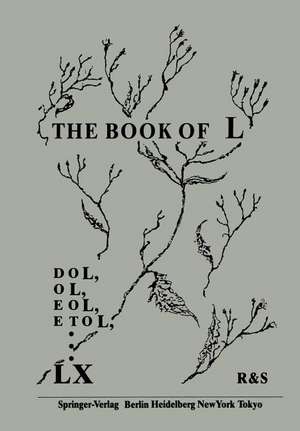The Book of L
Editat de G. Rozenberg, A. Salomaaen Limba Engleză Paperback – 9 feb 2012
Preț: 658.52 lei
Preț vechi: 823.15 lei
-20% Nou
Puncte Express: 988
Preț estimativ în valută:
126.02€ • 136.84$ • 105.86£
126.02€ • 136.84$ • 105.86£
Carte tipărită la comandă
Livrare economică 23 aprilie-07 mai
Preluare comenzi: 021 569.72.76
Specificații
ISBN-13: 9783642954887
ISBN-10: 364295488X
Pagini: 492
Ilustrații: XV, 471 p.
Dimensiuni: 170 x 244 x 26 mm
Greutate: 0.78 kg
Ediția:Softcover reprint of the original 1st ed. 1986
Editura: Springer Berlin, Heidelberg
Colecția Springer
Locul publicării:Berlin, Heidelberg, Germany
ISBN-10: 364295488X
Pagini: 492
Ilustrații: XV, 471 p.
Dimensiuni: 170 x 244 x 26 mm
Greutate: 0.78 kg
Ediția:Softcover reprint of the original 1st ed. 1986
Editura: Springer Berlin, Heidelberg
Colecția Springer
Locul publicării:Berlin, Heidelberg, Germany
Public țintă
ResearchCuprins
Investigations into Drosophila Wing Development — Results from a Lindenmayer Model.- Fibonacci Words — A Survey.- Planar Map Generation by Parallel Binary Fission/Fusion Grammars.- Modular Trellises.- A New Proof for the DOL Sequence Equivalence Problem and its Implications.- On Compound Lindenmayer Systems.- Graph Grammars with Application Conditions.- The ETOL Hierarchy is in the OI Hierarchy.- Polyhedral Cell Shapes.- On Cyclically Overlap-Free Words in Binary Alphabets.- The Theoretical Basis of the Transplantation Experiment.- Fixed and Stationary ?-Words and ?-Languages.- DOL Schemes and Recurrent Words.- Stochastic OL Systems and Formal Power Series.- Complexity of L-Systems.- Compartmental Hybrid State Production-Diffusion Systems with Application to Prestalk-Prespore Pattern Regulation in Cellular Slime Molds.- Hierarchical Aspects of Plant Development.- Rule Trees Represent Derivations in Edge Replacement Systems.- Languages Defined by Indian Parallel Systems.- L Systems and NLOG-Reductions.- The Parikh-Boundedness of ETOL Languages of Finite Index.- Computer Networks with Compact Routing Tables.- Unconventional Leaves.- A Uniform Model for the Growth of Biological Organisms: Cooperating Sequential Processes.- Graph Technology Applied to a Software Project.- Some Systems for Map Generation.- A Programming Language for Lindenmayer Systems.- A Note on Significance of Cellular Interaction in L-System.- EOL Grammars and Search Trees.- Variation in Inflorescence Structure in Cotoneaster Franchetti.- Partial Path Groups and Parallel Graph Contractions.- When L was Young.- Equivalence Problems for Regular Sets of Word Morphisms.- Parentheses Grammars and Lindenmayer Grammars.- Array Languages and Lindenmayer Systems — A Survey.- Symmetric DistributedTermination.- Development, Growth and Time.- On the Set of all Subgraphs of the Graphs in a Boundary NLC Graph Language.- Graph-Controlled Systems — An Extension of OL Systems.













